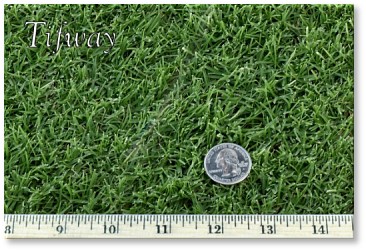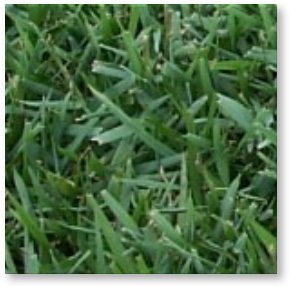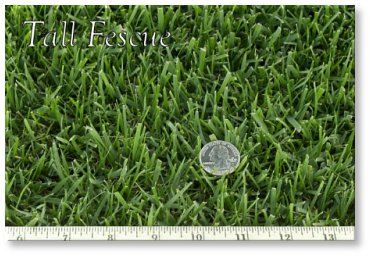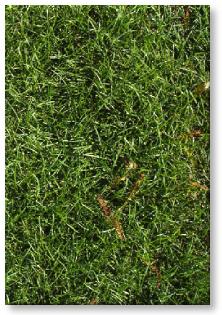No matter
how beautiful a house may be, if it has
an unkept yard and dying grass it will
be an eyesore. A lawn of luscious green
grass is a beauty to behold and joy to
walk on, play and enjoy. The value of
your home will be increased greatly if
you have a lush green lawn. There are
three necessary elements in order to have
a beautiful lawn; the right grass type,
good soil, and good drainage.
When planning for a lawn you should take
into consideration your lifestyle and
feelings about maintenance. Whether your
lawn is large or small, you can make it
appealing by selecting the right grass
type and ensuring that it's shape fits
in well with other elements of the landscape.
If you are having touble deciding the
shape of your lawn consult with a professional
landscaper or landscape
designer who can help assist you.
Soil preparation is critical to the success
and the long-term health of your lawn.
Testing the soil is highly recommended
so that you can identify defiencies and
then add the appropriate ammendments.
You also want to make sure that the grade
is such that there will be no wet spots
or other drainage issues.
Most types of lawns for the south can
be started from seed, except for Meyers
zoysia and St. Augustine. Once your lawn
is established you can ensure that your
it remains healthy by providing regular
fertilizer treatments, aeration, mowing,
edging and pest control when needed.
The types of lawn grasses to choose from
in the mid-Georgia area are:
 |
Bermuda
- Bermuda
is the most popular selection for
lawns in our area. Bermuda provides
a deep green turf and handles foot-traffic
well. Bermuda requires full sun and
does not tolerate shade. For best
results seed between April 15 - Aug.
15 and sod May 1 - Sept 15. -Maintaining
a Bermuda Lawn |
| |
|
 |
Centipede
- Known
as the 'lazy man's grass' centipede
is our favorite choice for mid-Georgia.
It's especially good for larger lawns
as it requires less frequent mowing.
Centipede lawns do not require liming
and are the most shade tolerant of
the warm season grasses. For best
results seed between April15 - July
15 and sod May 1 - Sept 1. Maintaining
a Centipede Lawn |
| |
|
 |
Zoysia
- 'Meyers'
Zoysia is known as the cadillac of
lawn grasses. The turf is a deep vibrant
green and very dense. Zoysia needs
sun and will thin out considerably
near the root systems of large trees.
We recommend Zoysia for smaller lawns.
(10,000 Sq, Ft.or under). For best
results sod between May 1 - Sept 1.
Maintaining
a Zoysia Lawn |
| |
|
 |
St.
Augustine -
St. Augustine can be grown in our
area, but is probably the least popular.
'Raleigh' is the most cold hardy variety
we know of. Grows in sun however shade
tolerance is good. For best results
sod between May 1 - Sept 1. Maintaining
a St. Augustine Lawn |
| |
|
 |
Fescue
- Fescue
is a good selection for shadier lawns.
It will require some management and
usually needs reseeded every year.
A new variety: 'RTF
Advantage' is self-repairing.
It shouldn't be cut below 4"
in summer due to risk of burnout.
Always select a 'turf-type' variety.
Fescue should be seeded in spring
or fall. Maintaining
a Fescue Lawn |
| |
|
 |
Blue
Grass 'Thermal
Blue' - This is
a new selection of Bluegrass that
has shown through trials to be quite
heat tolerant in the deep south. We
are testing it in our own yards to
see how well it performs before recommending
it. If you are interested in trying
it out, we do keep a small amount
on hand. Seed bluegrass in spring
or fall for best results. |
Planting
a New Lawn
For your lawn to prosper you must have
good, rich soil. Soil is important because
it not only provides the water for your
grass to grow, but it also provides nutrients
and a place for the roots of the grass
to anchor.
You should test your soil to see if the
PH, or alkalinity and acidity, is correct.
Buy a soil testing kit at a garden center.
Collect samples of your soil by going
at least 6 inches deep and mixing the
soil from several different locations
in the dirt plot. For fescue, bermuda,
zoysia and bluegrass the PH reading you
need is around 7. If it is below that
then your soil is acidic and you need
to add lime. If your PH is above 7 then
your soil is alkaline and you need to
add sulfur to make it more acidic. Centipede
lkes our acidic soil however prefers it
on the sandy side.
Drainage
- Before planting a new lawn any drainage
problems should be identified and corrected.
If you know that there are drainage problems
we would recommend hiring a professional
grading contractor to correct the problem.
Professional graders will use a laser
transit to ensure proper drainage.
 Lawn
Bed Preparation - Once
drainage issues, if any, are taken care
of you are now ready to prepare the seed
or sod bed. The bed should be tilled or
plowed to a depth of 4-6" and then
raked smooth. If your soil is very poor
or hard-packed clay you should apply a
liberal layer of screened topsoil, sand,
and/or composted soil ammendment to ammend
soil before tilling. Remove any rocks
larger than a quarter in diameter as you
rake to smooth. Lawn
Bed Preparation - Once
drainage issues, if any, are taken care
of you are now ready to prepare the seed
or sod bed. The bed should be tilled or
plowed to a depth of 4-6" and then
raked smooth. If your soil is very poor
or hard-packed clay you should apply a
liberal layer of screened topsoil, sand,
and/or composted soil ammendment to ammend
soil before tilling. Remove any rocks
larger than a quarter in diameter as you
rake to smooth.
If you are really serious about having
a beautiful lawn hire a reputable local
landscaper who has the right equipment
and expertise to prepare your lawn bed
as if it were going to be a putting green.
Always make sure when hiring a contractor
to get at least three references. Ask
to see a portfolio or obtain a list of
addresses where you can go to take a look
at the contractors past work.
Broadcasting Seed - If
you are planting your lawn from seed you
will need to use a rotary spreader to
broadcast the seed. DO NOT use drop spreaders.
Walk behind and shoulder broadcast spreaders
work well for fescue and bermuda. Centipede
is best broadcasted with a smaller, hand-held
box spreader that has micro-settings for
their tiny seeds. We don't recommend blending
your seed with sand.
 |
TIP:
When broadcasting the seed make two
passes over the entire lawn area,
going the opposite direction the second
pass. This will ensure more even coverage
and minimize bare spots. |
Fertilizing
- Always broadcast a good
starter fertilizer when planting a new
lawn. broadcast fertilizer before you
lay sod or broadcast seed. Spreading rates
should be labeled on the bag. Broadcast
the starter fertilizer the same way you
applied the seed making two passes going
in opposite direction the second pass.
Liming
- All new lawns should be limed except
for centipede which doesn't require lime.
We recommend testing your soil for ph
so that you will know how much to apply.
A general rule of thumb for mid-Georgia
lawns is 40 lbs. of lime per 500 - 1,000
square feet. Most soil tests sent to extension
services come back with these recommendations.
However, it is best to test your soil
to know for sure.
Mulching
- After seeding it will be necessary to
shake a thin layer of wheatstraw over
the newly planted lawn bed. Wheat straw
will help hold seed in place if it rains
and also help to retain moisture, resulting
in quicker germination and estalishment
of lawn. A bale of wheatstraw usually
covers about 300-400 sq. ft. when distrubuted
enough just to conceal the soil.
Water
- Water every day when there is no rain
until seeds germinate and as needed after
that.
Laying
Sod - Make sure to order
sod from a reputable supplier. Schedule
the delivery of your sod only when you
know for sure the time that you will be
able to begin laying it. Weather conditions
have a way of disrupting schedules and
you don't want to end up with several
pallets of sod on site having to wait
through 3 days of rain. So, when finish
grading and raking is completed, and you've
checked the forecast, you may order sod.
Most sod companies can schedule delivery
next day or day after.
Be there when the sod arrives. You will
want to strategically place the pallets
of sod i a way that will reduce unnecessary
labor to lay it. A pallet of sod generally
has 450 to 550 sq. ft. per pallet depending
on the variety.
TIP: Mark out squares
on the ground that are 20' x 25' and have
the pallets set just outside of these
squares.
Before laying sod broadcast starter fertilizer,
and lime if required.
 |
To start laying your
sod find a straight or long line/edge
and begin there. Lay down one row
and stager the next row as in a brick
pattern. Continue with this pattern
until you are finished. |
After all of the sod has been laid trim
around the perimeter with a machete, bushaxe,
or other sharp instrument.
Water every day when there is no rain
until sod is firmly rooted and as needed
after that.
Reseeding
Your Fescue Lawn
Bermuda, Centipede, and Zoysia lawns
do not require reseeding. If you have
one of these lawns and your grass is looking
dingy, or thinned out, it is probably
due to weather, pest or disease damage,
poor drainage, hard packed soil, or insufficient
supply of elements or nutrients in the
soil. Give Wilson Bros. Nursery or a lawn
maintenance professional a call and they
will help to identify the problem. You
may also e-mail
your questions.
CAUTION: Never overseed
a bermuda lawn that was established from
hybrid sod sod. Nybrid sod bermuda will
not match up with bermuda types grown
from seed - not even the 'turf-type' bermuda
from seed.
If you have a fescue lawn it will probably
need reseeding at least one time per year
- preferably in the fall (October is best).
However, there is a new self-repairing
type of turf-type fescue out these days
called RTF
Advantage Fescue that you may plant
in spring. We are now stocking it at the
nursery during spring and fall.
To overseed a fescue lawn with RTF
Advantage Fescue (which can be blended
with any other type of fescue), you will
need to aerate the lawn area with a core
(or plug) aerator. Make several passes
with the aerator over the lawn area.
TIP: Plug aeration usually
works best when done the day after a good
rain. You can also soak the yard down
with a sprinkler the day or evening before.
 |
When
broadcasting the seed use a rotary-type
spreader making two passes over the
entire lawn area, going the opposite
direction the second pass. This will
ensure more even coverage and minimize
bare spots. |
Then broadcast starter fertilizer and
pelletized lime using a rotary spreader.
Spread wheatstraw over bare areas and
on slopes where the existing grass has
thinned out or disappeared. Water every
day that there is no rain until seeds
germinate and as needed after seed has
germinated.
Seeding
Rates
Type
of Grass Seed |
Lbs. Per 4,000 Square Feet |
| Turf-Type Fescue
|
25
(Overseeding: 15) |
| Centipede |
1 |
| Turf-Type Bermuda
|
8 |
| Ryegrass (Overseeding) |
40 |
| |
|
For information about maintaining or
planting a lawn select from a category
below:
Maintaining
a Bermuda Lawn
Maintaining
a Centipede Lawn
Maintaining
a Zoysia Lawn
Maintaining
a St. Augustine Lawn
Maintaining
a Fescue Lawn
Restoring
a Lawn
Planting
a Lawn from Scratch
If you are having trouble
getting grass to grow under trees or in
dense shade areas consider planting evergreen
groundcovers
that will thrive in these conditions.
|